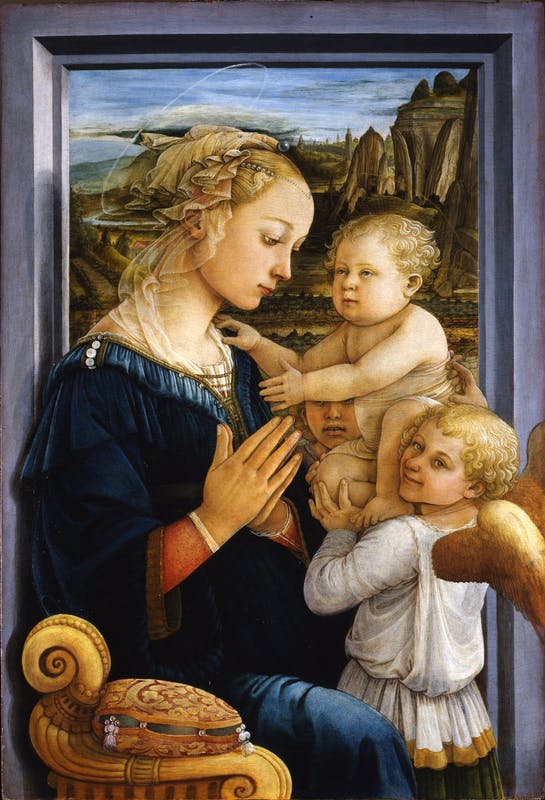Men prove particularly ominous in “Costa Magic,” the third and final poem in the sequence of “Italian Pictures.” As in the previous two poems in the series (“July in Vallombrosa” and “The Costa San Giorgio”), the female speaker initially is positioned as an observer of her surroundings but in “Costa Magic” she chooses to join the community of women that form to care for a sick neighbor girl, Cesira. This community rises in response to the patriarch who looms over the street scene in disapproval of his daughter’s plans to marry. He breaks the space of the first line’s insistent flush right arrangement, as though bursting the white space of the page to enter and generate the poem.
 What is this “conception,” with its clear suggestions of fertility as a daughter’s duty but also in the sense of “conception” as a concept or plan or symbolic image? Symbolic image and biological pregnancy intertwine in the Catholic dogma of the Immaculate Conception, God’s intervention at the moment of Mary’s conception in the womb of Saint Anne, her mother, to absolve her of original sin so that the divine plan for Mary as the Mother of God might be realized without taint. (See Loy’s “Portrait of a Nun,” ‘mystic conception’.) What, however, is the “this one / Here” or the “yellow hair”? Is the father imagining a hearty (male) child that he wishes his daughter could conceive, Christ-like with “yellow hair” common to Florentine Renaissance iconography of the baby Jesus, as in Fra Lippo Lippi’s typical rendering in the “Madonna with the Child and Two Angels” (housed in Florence’s Uffizi gallery)?
What is this “conception,” with its clear suggestions of fertility as a daughter’s duty but also in the sense of “conception” as a concept or plan or symbolic image? Symbolic image and biological pregnancy intertwine in the Catholic dogma of the Immaculate Conception, God’s intervention at the moment of Mary’s conception in the womb of Saint Anne, her mother, to absolve her of original sin so that the divine plan for Mary as the Mother of God might be realized without taint. (See Loy’s “Portrait of a Nun,” ‘mystic conception’.) What, however, is the “this one / Here” or the “yellow hair”? Is the father imagining a hearty (male) child that he wishes his daughter could conceive, Christ-like with “yellow hair” common to Florentine Renaissance iconography of the baby Jesus, as in Fra Lippo Lippi’s typical rendering in the “Madonna with the Child and Two Angels” (housed in Florence’s Uffizi gallery)?
This act galvanizes a specifically male force on the street, as the speaker’s “I” realizes she hears her husband’s voice accompanying the father’s act in a ritual robbing the young woman of her life:
While listening up I hear my husband
Mumbling Mumbling
Mumbling at the window
Malediction
Incantation
White spaces within the lines again yawn as chasms of male power into which a woman can fall victim, while the columns of words visually divide the linear progression of the narrative, a move both Futurist in its use of typographic disruption and anti-Futurist in its indictment of a collective phallocentrism (evoked by the columns) tethering traditions of marriage and church with avant-garde revolution in a shared system of misogyny : “I hear my husband/ Mumbling / at the window.” Mable Dodge, in her autobiography, comments that Stephen Haweis would “delve into magic things and knew a few little magical tricks,” suggesting Loy ominously mirrors her husband in the poem (338).
Unlike in “Costa San Giorgio,” though, the female speaker of “Costa Magic”—self-identified as a wife—is now on the street while the husband is at the window. She has moved from outsider to participant, described by Tara Prescott as a “closeness, either emotionally or physically” (19) and by Carolyn Burke as a moment in which the “distance between observer and subject could collapse in moments of sympathy when—as in Futurist painting—she place herself inside of the scene” (199).
In their waiting and their trust in the magic tree’s revelation, the community of women implicitly share the speaker’s condemnation of the father’s “unnatural” relation with his daughter, a “Bewitching” rife with erotic, incestuous suggestions:
It is unnatural in a Father
Bewitching a daughter
Whose hair down covers her thighs
This final stanza rediagnoses the ailment from the counter-magical perspective of women, a perspective perceiving an “unnatural” system of masculine power crossing and linking all nodes of authority. This understanding of a collective complicity that protects men and keeps them in power occupies the final line’s white spaces, chiming with other chasms severing the poem’s lines to register unspoken silences structuring women’s lives.
The poem’s compositional architecture, made up of glimpses and pieces, creates a network of connections between male-centered structures that collude in enforcing such silences as in, for example, the use of the upper-case F in the final “Father” that links the human “father” opening the poem with a patriarchal god. From that association, others multiply, such as the suggestive use of the word “conception” to point toward the Immaculate Conception as a narrative made by men for men to circumscribe and exploit women’s sexuality—as the human father possesses the daughter sexually but must maintain the illusion of her purity, the god-father removes the taint of original sin in joining with his daughter.
